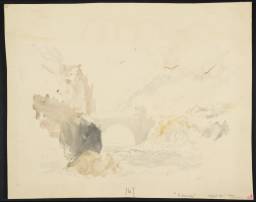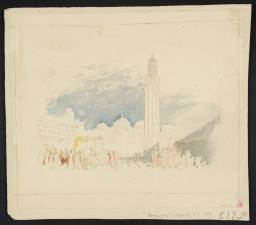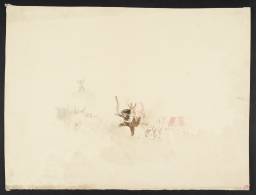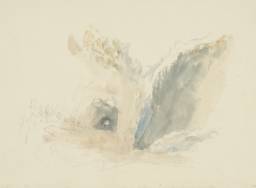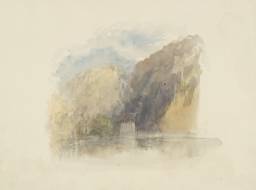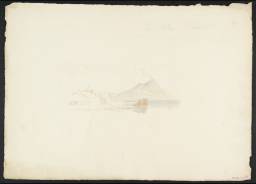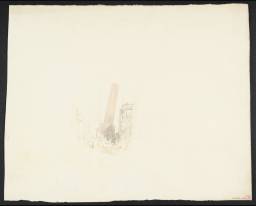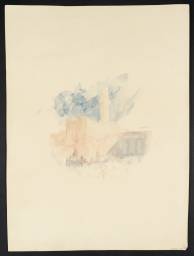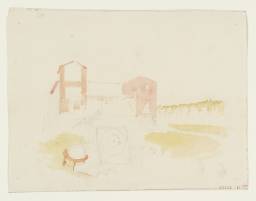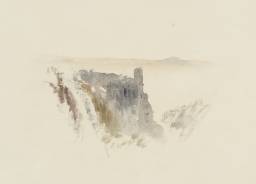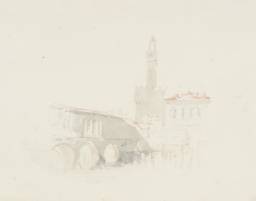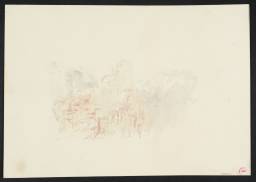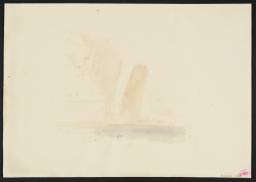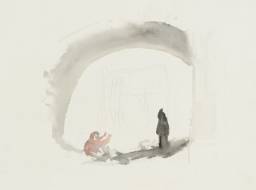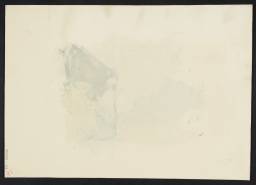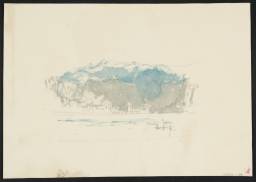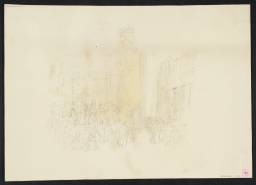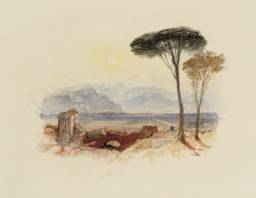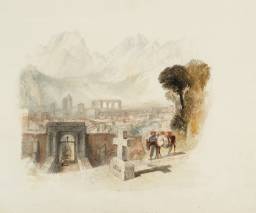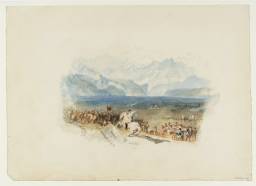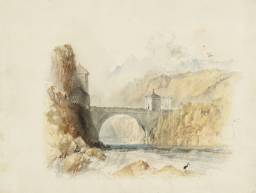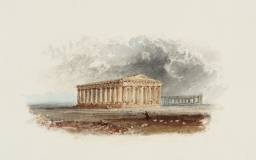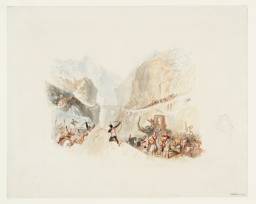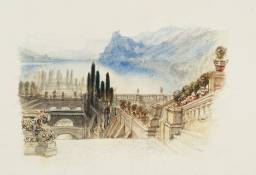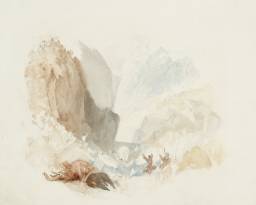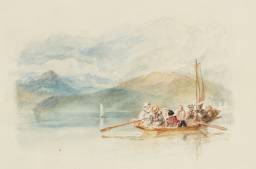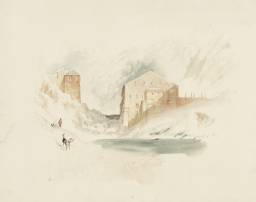Turner Bequest CCLXXX 1–2; 6; 8–9; 13–14; 22; 87–88; 92, 95; 101–107; 143–161; 163–167; 193; verso of 164
References
In 1826, Turner began work on a group of vignette illustrations for a luxury edition of Samuel Rogers’s long poem, Italy. Of all the poets whose works Turner illustrated, such as Byron, Scott, Campbell, and Milton, Rogers is probably the least well known today. However, the vignettes that Turner created for Italy (1830), and, shortly thereafter, for Rogers’s Poems (1834), are considered to be his finest works of literary illustration.
Samuel Rogers (1763–1855), a wealthy banker turned poet, achieved literary renown with his enormously popular poem The Pleasures of Memory (1792).1 Although he would never surpass this early success, he nonetheless remained deeply engaged in the cultural circles of early nineteenth-century London. His famous breakfast parties at his house in St James Place brought together the artistic and literary luminaries of the day, including Turner and a number of poets whose works Turner would later illustrate. An imaginary version of one such gathering can be seen in Charles Mottram’s engraving of 1823 (Tate T04907).
In 1815, Rogers made his first visit to Italy, where he was enthralled by the historical and cultural richness of his surroundings. He wrote to one friend, ‘Oh if you knew what it was to look upon a Lake which Virgil has mentioned & Catullus sailed upon, to see a house in which Petrarch has lived.’2 Rogers’s travels abroad became the source of inspiration for his long poem Italy, in which the narrative interweaves personal experience with sentimental storytelling and historical reflection.
When Part I of Italy was first published by Longman in 1821–2, it met with a lukewarm reception. Rogers, however, was a man endowed with a perfectionist nature and unlimited personal funds, and he persevered with his endeavour. By 1828, he had issued three revised editions of Part I, as well as a first edition of Part II. In 1824, he had bought up 548 copies of Italy (presumably all that was left of the third edition) in order to issue the fourth edition and even more drastic was his decision to halt the 1828 republication of Italy in order to ‘make some Alterations.’ In this case, Rogers appears to have bought up and ‘made a bonfire’ of no less than two thousand copies of the book.3 As he assured one friend ‘money in such matters is no object’.4 He also commissioned illustrations for a new luxury edition of the complete work. Frederick Goodall, the son of the engraver Edward Goodall, offers one account of how the idea for an illustrated Italy may have come about: ‘Rogers having expressed to Turner the opinion that nobody ever read his poems, Turner demurred, but added with emphasis, “Then they shall read them, and no lady’s boudoir shall be complete without a copy, for I will make them attractive with illustrations.” ’5 Whether this little tale is true or not, Turner seems to have welcomed the opportunity to illustrate the publication. Rogers’s poetic style, which was heavily influenced by the Augustan poets, as well as his reverence for Italy, were well in line with Turner’s own tastes and sensibilities.6
Rogers commissioned nearly fifty vignettes for Italy. Twenty-five were completed by Turner and nineteen by Thomas Stothard (1755–1834), a celebrated illustrator of literary subjects. In his preface, the poet praised these ‘two Artists, who have contributed so much to give it a value, [and who] would have done honour to any age or country.’7 Given how closely the poet attended to all aspects of the book’s production, it seems likely that he was involved in the selection of subjects for illustration. Turner’s notes on several trial proofs of engravings for Italy and Poems show that Rogers also reviewed the vignettes before they were finally approved for publication.8 Rogers would later express great satisfaction with the work of both artists, telling a friend that ‘Turner and Stothard entered into his views without difficulty in the Illustration of his Italy & Poems. Assisted each other, did whatever he wished.’9
Turner’s designs were transferred onto steel plates by a team of thirteen highly skilled engravers, including Edward Goodall and John Pye. Steel engraving, which came into use in the early 1820s, was the finest and most expensive printing method available at this time and Rogers paid sums ranging from 20 guineas to £40 for the engraved Italy illustrations.10 Much harder than copper, steel allowed for finer lines and subtler effects, while also yielding a much larger print run. Another innovative but costly feature of Rogers’s Italy was the manner in which the vignettes were printed. Rather than have printed text and image appear on opposite pages, the vignettes appeared on the same page as the corresponding poems. Every illustrated page was therefore required to pass through the press twice, a procedure that required enormous care and further raised the book’s production costs.
Rogers clearly intended to produce a publication of exceptional quality, a feat which he happily achieved, though with no small cost to himself. Italy was published in 1830 by Thomas Cadell and the young Edward Moxon, whom Rogers had helped set up in business.11 Such a joint venture was common, especially for such an expensive and ambitious product. However, it was Rogers himself who financed the book’s production. In all, the poet paid a total of £7,755 4s. 10d. to publish the first run of Italy,12 the exact costs being: imperial quarto £2 12s. 6d; India proofs, with letters £3 13s 6d; and India proofs before the letters £4 4s.13 The Athenaeum reported that ‘Lovers of the arts strove to acquire the finest proof impressions of the vignettes and raised public outcry when they believed they were being fobbed-off with inferior ones.’ 14 The book appeared in two editions, one selling for £1 8s. and one for £3 3s. Portfolios of the vignettes alone could also be purchased for sums ranging from £2 12s. 6d. to £4 4s. The project would have been even more costly had Rogers paid Turner £50 per illustration, as had originally been agreed. However, in order to reduce publishing costs, Turner offered to loan him the watercolours at a rate of 5 guineas each (or £5 per loaned watercolour according to another source).15
With the exception of several vignettes that Turner designed for Walter Fawkes in 1819–22, the designs for Italy represent his first illustrations to a work of literature. Turner was particularly well equipped to illustrate Rogers’s poem, having already produced a series of drawings for another well-known book on Italy, James Hakewill’s Picturesque Tour of Italy (1818–20).16 For this project, Turner translated Hakewill’s pencil drawings into watercolour compositions that were in turn engraved for publication. In 1819, Turner made his first tour of Italy, where he visited most of the sites that he would later illustrate in Rogers’s volume. Although he may have referred to his Italian sketchbooks when preparing the vignettes, he did not rely too heavily upon them. Designs such as The Forum, Paestum, and A Farewell: Lake of Como II stray significantly from Turner’s more accurate on-site sketches of these subjects (Tate D27675, D27665, D27667; Turner Bequest CCLXXX 158, 148, 150). However, neither Turner nor his audience seem to have been concerned by such distortions; it was well understood that the purpose of the vignette was to evoke the idea and feeling, rather than the exact appearance of a given place.
Although Turner’s vignettes can rarely be described as straightforward illustrations of Rogers’s text, they clearly reflect the artist’s close engagement with the poem at hand. Nearly every vignette contains some allusion to details mentioned in Rogers’s text, for example a group of peasants travelling on the Lake of Geneva, or an awestruck figure gazing at decaying Roman temples (Tate D27669, D27665; Turner Bequest CCLXXX 152, 148). Most importantly, however, Turner’s views provide a breathtaking visual backdrop for the sentimental tales and historical musings that characterise Rogers’s poems. The reader can gaze at leisure upon the shimmering Lake of Como or the ruin-strewn Campagna while reading the author’s historical musings about the ancient philosophers and warriors who once were there. In this way, the vignettes tend to complement, rather than illustrate, Rogers’s text.
Although Turner’s vignettes can rarely be described as straightforward illustrations of Rogers’s text, they clearly reflect the artist’s close engagement with the poem at hand. Nearly every vignette contains some allusion to details mentioned in Rogers’s text, for example a group of peasants travelling on the Lake of Geneva, or an awestruck figure gazing at decaying Roman temples (Tate D27669, D27665; Turner Bequest CCLXXX 152, 148). Most importantly, however, Turner’s views provide a breathtaking visual backdrop for the sentimental tales and historical musings that characterise Rogers’s poems. The reader can gaze at leisure upon the shimmering Lake of Como or the ruin-strewn Campagna while reading the author’s historical musings about the ancient philosophers and warriors who once were there. In this way, the vignettes tend to complement, rather than illustrate, Rogers’s text.
Italy was an instant success with critics and public alike: 6,800 copies sold within two years of its publication, and five reprints had appeared by 1859.17 One ecstatic reviewer declared:
This is such a volume, that we fear never to look upon its like again – it beats all the annuals together. Poetry, wealth, taste, are here blended beautifully, and the result is the most splendid piece of illustrated typography it has ever been our fortune to look on ... let all that have taste, or pretend to it, strive for an early copy, and treasure it as the jewel of their libraries.18
It was not uncommon, however, for Turner’s designs to be praised at the expense of Rogers’s verse. The same author also wrote: ‘It may be a little ungrateful to Rogers, but we cannot attend to him now ... it is impossible to do anything but turn from picture to picture, from jewel to jewel.’19 Another contemporary put it less politely in this clever little rhyme:
Rogers’s Italy set a new standard for illustrated books and its commercial success inspired many poets and their publishers to follow suit. When discussing the possibility of asking Turner to provide illustrations for an edition of Sir Walter Scott’s Poetical Works, Thomas Cadell assured Scott that ‘with his [Turner’s] pencil I shall insure the subscription of 8,000 – without, not 3,000.’21
Even before Italy was published, Turner probably began designing vignettes for a second Rogers’s volume, Poems (see the Introduction to Rogers’s Poems).22 By this time the artist and poet had become good friends. When Turner drew up his second will in June 1830, he added Rogers’s name to his list of executors.23
By 1847, a total of 50,000 copies of Poems and Italy had been sold making Turner’s art accessible to an unprecedented number of British viewers.24 Among them was the young John Ruskin, who received a copy of Italy on his thirteenth birthday and would later ‘attribute to the gift the entire direction of my life’s energies.’25 It is Rogers’s biographer, P.W. Clayden, who offers the most eloquent summary of the significance that these vignettes had, both for Turner and for his audience:
There can be little doubt that the illustrations to Italy and the Poems first made Turner known to the vast multitudes of the English people. One of the most vivid recollections of my own boyhood is the wakening up of a new sense of an ideal world of beauty as I lingered over the lovely landscapes on these delightful pages ... there are many whose recollections of these two volumes harmonise with mine, to whom they were an education, and who learned from them to admire Turner before they had actually seen one of his paintings.26
All of Turner’s finished watercolour vignettes related to Rogers’s Italy are in the Turner Bequest, apart from one, Hospice of St. Bernard II (Frances Lehman Loeb Art Center, Vassar College, Poughkeepsie).27 There are also a considerable number of preparatory studies. Catalogue entries are listed below according to their order of appearance in Rogers’s text, with any related preliminary studies. Any studies that relate to the series but do not appear to pertain to a published work appear at the end. This assigned sequence disrupts the partially consecutive run of Tate accession numbers and Turner Bequest numbers.
| Rogers’s Italy vignette title | Published page reference | Tate number | Turner Bequest (Finberg) number | Rawlinson number and related Tate number | Related studies |
| The Lake of Geneva | p.1 | D27669 | CCLXXX 152 | R348 T04631 and T04632 | D27526 CCLXXX 9 D27623 CCLXXX 106 |
| The Chapel of William Tell | p.8 | D27672 | CCLXXX 155 | R349T04633 | D27622 CCLXXX 105 |
| St Maurice | p.9 | D27664 | CCLXXX 147 | R350T04634 | D27518 CCLXXX 1 |
| The Hospice. Great St Bernard with the Lake (I) | p.11 | D27670 | CCLXXX 153 | R351T04635 and T04636 | |
| Marengo | p.17 | D27663 | CCLXXX 146 | R353T04639 | |
| Aosta | p.25 | D27662 | CCLXXX 145 | R354T04640 and T04641 | |
| Martigny | p.28 | D27671 | CCLXXX 154 | R355T04642 and T04643 | |
| Hannibal Passing the Alps | p.29 | D27666 | CCLXXX 149 | R356T04644 | D27523CCLXXX 6 D27525 CCLXXX 8 D27668 CCLXXX 151 |
| Lake of Como (I) | p.32 | D27674 | CCLXXX 157 | R357T04645 | |
| Venice | p.47 | D27710 | CCLXXX 193 | R358T04646 | D27519 CCLXXX 2 |
| Florence | p.102 | D27673 | CCLXXX 156 | R359T04647 and T04678 | D27612 CCLXXX 95 D27539 CCLXXX 22 |
| Galileo’s Villa | p.115 | D27680 | CCLXXX 163 | R360T04649 and T04650 | D27604 CCLXXX 87 |
| A Villa (Villa Madama – Moonlight) | p.135 | D27676 | CCLXXX 159 | R361T04651 | D27652 CCLXXX 135 D27659 CCLXXX 142 |
| The Forum | p.137 | D27675 | CCLXXX 158 | R363T04653 and T04654 | D27620 CCLXXX 103 D27621 CCLXXX 104 |
| Campagna of Rome | p.153 | D27678 | CCLXXX 161 | R364 T04655 and T04656 | |
| Rome (Castle of St Angelo) | p.158 | D27677 | CCLXXX 160 | R362T04652 | |
| Tivoli | p.166 | D27683 | CCLXXX 166 | R365T04657 and T04658 | D27605 CCLXXX 88 |
| Perugia | p.168 | D27661 | CCLXXX 144 | R366T04659 and T04660 | |
| Banditti | p.183 | D27681 | CCLXXX 164 | R367 T04661 | D41487 Verso of CCLXXX 164 |
| Bay of Naples | p.189 | D27660 | CCLXXX 143 | R368T04662 and T04663 | D27530 CCLXXX 13 |
| Temples of Paestum | p.207 | D27665 | CCLXXX 148 | R369T04664 and T04665 | D27609 CCLXXX 92 |
| Amalfi | p.216 | D27684 | CCLXXX 167 | R370 T04666 and T04667 | D27618 CCLXXX 101 |
| A Villa. Moon-Light (A Villa on the Night of a Festa di Ballo) | p.223 | D27682 | CCLXXX 165 | R371T04668 and T04669 | |
| Lake of Como, II (A Farewell) | p.233 | D27667 | CCLXXX 150 | R372T04670 | |
| Miscellaneous study | D27531 | CCLXXX 14 | |||
| Miscellaneous study | D27619 | CCLXXX 102 | |||
| Miscellaneous study | D27624 | CCLXXX 107 |
The titles given follow those listed by Jan Piggott in his catalogue of Turner’s vignettes, which in turn are those given by Samuel Rogers or the publisher Edward Moxon on the finished portfolio engravings and in the 1838 quarto editions.28
Cecilia Powell, ‘Turner’s Vignettes and the Making of Rogers’ “Italy” ’, Turner Studies, vol. 3, no. 1, 1983, p.2.
See Turner’s touched proofs of St Anne’s Hill (II) and Banditti at the Yale Center for British Art. B1977.14.7357 and B1977.14.7245.
Luke Herrmann, Turner Prints: The Engraved Work of J.M.W. Turner, Oxford 1990, p.183 and Powell 1983, p.12 note 32.
W.G. Rawlinson, The Engraved Work of J.M.W. Turner, R.A., London 1908, vol.I, p.li, and see also the inscription in the copy of Italy belonging to Alexander Dyce, now in the Victoria and Albert Museum.
For more on this project, see Cecilia Powell, ‘Topography, imagination and travel: Turner’s relationship with James Hakewill’, Art History, vol.5, no.4, December 1982, pp.409–25.
How to cite
Meredith Gamer, ‘Watercolours Related to Samuel Rogers’s Italy c.1826–7’, subset, August 2006, in David Blayney Brown (ed.), J.M.W. Turner: Sketchbooks, Drawings and Watercolours, Tate Research Publication, December 2012, https://www

